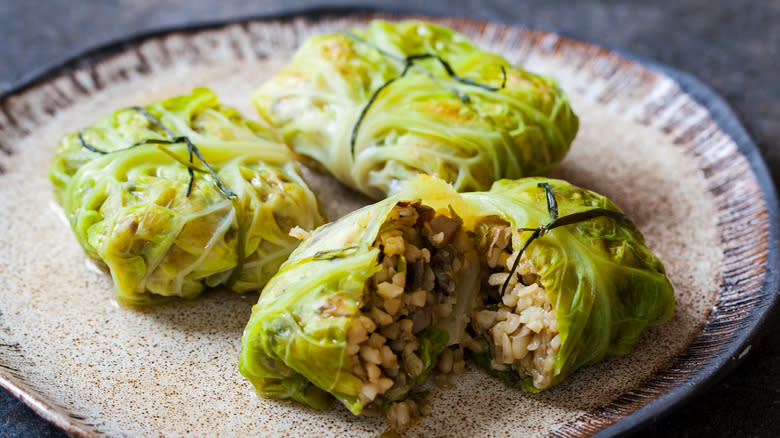Alton Brown's Edible Twine Swap For Tying Grilled Fish

- Oops!Something went wrong.Please try again later.
Last year, Alton Brown, "Good Eats" creator, host, and culinary entertainer-educator extraordinaire posted an innocent enough-looking photo to his Instagram: A few pairs of fish filets stuffed with herbs. But what really caught people's attention was how he had tied the pairs of filets together.
Brown reveals the answer to this in the post's caption: "No strings for your herb-stuffed trout? Chives for the win." The passionate foodie uses a readily available herb in place of twine. And it isn't just a direct replacement; since chives are edible and full of flavor, using these to tie fish filets together on the grill imparts the fish with extra herby flavor and avoids the sometimes unpleasant experience of removing inedible things like string from your food before eating.
Alton Brown is known for his creative yet accessible approach to cooking and food, and a DIY cooking tip like this is very much in his wheelhouse. However, it's worth noting that this idea isn't original to Brown. Chives have been used for their flavor in cooking for millennia, but using chives as edible twine seems likely to have come into fashion with the rise of fine dining in the 20th Century.
Read more: 12 Underrated Types Of Fish You Should Try At Least Once
Edible Chive Twine Explained

Before you start wrapping chives around every food you want to hold together in the kitchen, there are some very simple (but very important) preparation tips you need to know. First, use fresh chives only. If they're starting to go soggy or wilt, they'll lose their structure and break much more easily. Second, and most importantly, you need to blanche your chives in boiling water before using them as twine. Doing this changes their structure, making them substantially more resistant and easier to tie without snapping them. Be careful: Don't overcook them or the opposite will happen and they'll soften, so blanche them for no more than 5 seconds, then transfer them to a bowl of ice water to stop them from cooking any further.
Now your chive string is ready for use! There's no use in pretending chive string is as sturdy as butcher's twine, but it's sufficient for plenty of preparations you can try at home. You can use it to wrap herbs together if you're keen to experiment with a bouquet garni or to tie a range of different leaf-wrapped recipes from around the world. Where it comes into its own is as a beautiful, zero-waste presentation for delicate dishes or, as Alton Brown put it to use, for grilling fish. You'd think the chives would burn on a grill, but since they've been blanched in water, they stay damp and resist charring for long enough to get your fish cooked perfectly.
Other Types Of Edible Twine

Of course, chives aren't the only edible substance in the world that can serve as a twine replacement. Japanese cooking, with its frequent emphasis on meticulous presentation and delicate detail, makes use of a range of ingredients (including chives!) as a replacement for the more unsightly and inedible string option. The most well-known is dry nori seaweed, which is often used to tie the rice and protein elements of sushi together. The tamago nigiri, for example, is almost always served with a 'belt' of nori holding the rice and sweet omelet together. There's also mitsuba, a Japanese wild parsley that can function as an edible string if you prepare it with the same blanch-then-chill method used to prepare chives for string-worthy kitchen duties.
Some ingredients more commonly available in Europe and North America can be used in place of kitchen twine when cooking, too. Celery is well-known for having 'stringlike' qualities; it peels a bit like string cheese, and you can peel these strips off to use as strings without needing to blanch. Leeks can also be used as a string alternative, but they're less well-suited for the job, as they don't tend to be as supportive as alternatives.
There are many more options to try than those listed above: Get creative! However, for an alternative to twine that's edible, accessible, and oh-so-easy to prepare, in Alton Brown's own words, it's "Chives for the win!"
Read the original article on Daily Meal.

